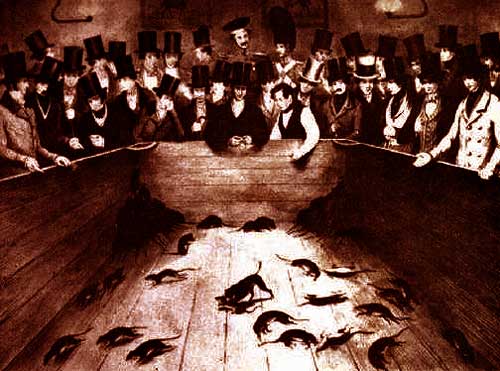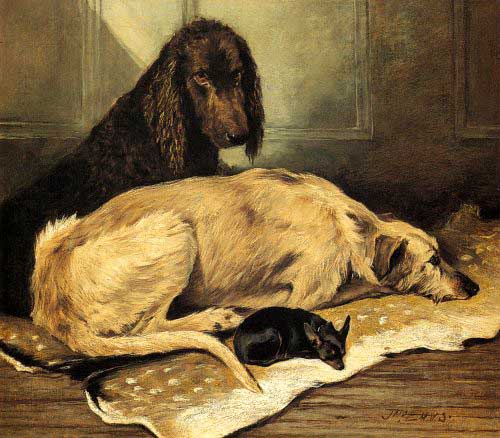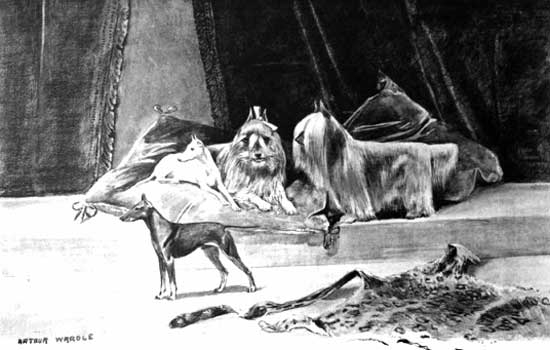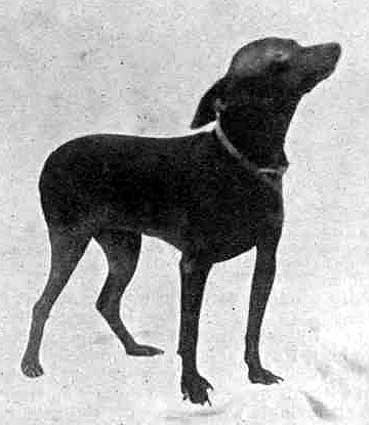
The Victorian "English Toy Terrier" in the topmost photo was named Misbourne Love Bird, belonging to Miss E. Green. She seems to be a solid-color, though most English Toys were tri-points, a diminutive form of the Black-and-Tan Terrier, which was in the main the same as the modern Manchester terrier.
The last illustration below is a drawing by Arthur Wardle, showing an English Toy Terrier and English White Terrier, the latter extinct, together witih a pair of Paisley Terriers, now extinct but the Yorkshire Terrier is descended from it.
Several of the Victorian toy breeds, which were such fads in their day, have become extinct due to health issue. But the English Toy Terrier survives as a viable breed. The weakness of the English White and the Toy Bull terriers was genetically connected to their white fur, and the fanatical quest for the perfect white brought with it several health concerns from general fragility to deafness.
That was not the case for of the tri-point on black-and-tan English Toy, though there are today white strains of the English Toy for which we should all be on guard against the same problems that resulted in the extinction of the English White which was, in essence, nothing more or less than a pure white form of the black-and-tan toy.
Immediately below is a painting by Victorian artist John Emms, a portrait of three dogs, Irish Water Spaniel, Scottish Deerhound, and English Toy Terrier that looks vastly more like a chihuahua than the usual black-and-tan English Toy.
The earliest chihuahuas in England were not given breed recognition by influential dog clubs, but were used in outcrossings with terrier breeds. Dogs like the English Toy and the English White which had long greyhound like heads (because already outcrossed with the diminuative Egyptian greyhound or whippet) began to be rounder or broader.
To this day, you will see English Toys and Manchester Terriers that look exactly like tri-point chihuahuas, which in turn undoubtedly got their tri-point coloration from outcrossing with these terriers. A mutual gene exchange!

The Victorian English Toy was always a sturdy little animal and though largely the pet of Victorian matrons, it was also a notable working dog, the smallest of the effective ratters that could get into small areas as easily as a ferret, and better than a ferret at killing its prey.
"Tiny in the Rat Pit" is shown in the engraving second from the top of this page. Tiny is furiously killing rats as a gamblers sport in 1848 England.
Tiny weighed only five and a half pounds when he killed 300 rats in under an hour, a record celebrated by the famous engraving. Gamblers' rat-pits were outlawed some while later and the small fighting terriers became house ratters exclusively. Because the English White was often deaf, it was no good even as a house ratter, and the popularity it held from the 1840s through the 1860s had ended by 1870, and they were extinct by the new century. But the black-and-tan toy was as fierce and effective as it's larger terrier cousins.
It was not until the 1920s that the black-and-tan terrier was officially divided into two breeds -- English Toy Terrier or Black and Tan which we would call a Miniature Manchester Terrier today. with the Toy Manchester Terrier quickly developed and was recognized as a third breed in 1938.
But these sundry "breeds" were somewhat illustory, because just like the chihuahua, dogs of differing sizes could arise from the same stock, even form a single litter. So in America, in 1958, the Miniature and the Toy Manchester were recombined as mere size variants of a single breed.
Then, startlingly enough, in 1962, the Toy Manchester was redefined in Great Britain as actually only an "English Toy Terrier," looking like and undoubtedly descended from the Victorian or Olde English Toy that had for about twenty years been regarded as an extinct breed though it had been present all along.



|

